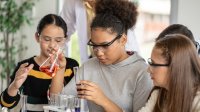Connecting High School Science to Sociocultural Issues
Science teachers can look for ways to connect their lessons to issues that students care about to boost engagement in learning.
Your content has been saved!
Go to My Saved Content.People who engage in authentic science have hypotheses about the world. They seek information that supports, extends, or conflicts with their understandings to establish more complete knowledge.
For educators looking to promote this type of thinking—this authentic science—in their classrooms, the following practices offer guidance.
Demonstrate and welcome different forms of engagement
Students’ identities and experiences may differ from yours and other students’. This means that the ways in which students demonstrate engagement in science may differ, as well, from your perspective on what it means to be a doer of science.
When we have a limited definition of engagement, we may also have a limited view of what counts as authentic science engagement and can limit the opportunities we provide students.
This means that we can first engage in a broadening of our definition and understanding of science. And from that broader understanding, we can provide multiple opportunities and ways for students to demonstrate their knowledge.
Use station activities
One strategy is to start the school year with station activities and problem-based or project-based experiences that require students to synthesize, hypothesize, analyze, and infer through modeling, reading, and writing.
A station activity that I’ve used is called Darwin’s Travels. During this activity, I introduce students to Darwin’s theory of evolution by engaging them in four stations that prompt them to make observations. Two of the stations that students explored were Brazil and the Galapagos Islands.
At Station 1, students got pictures of a variety (~40) of beetles. I read aloud, “Here, Darwin collected up to 68 different species of beetles in just a single day! Why do you think there are so many different species in one area? What could lead to this variety? How can so many species coexist? How might we be able to categorize these specimens? How might some stand out?” These questions support students to hypothesize, analyze, and infer patterns of diversity that underpin evidence for evolution.
At Station 2, I gave students a map of the Galapagos Islands and pictures of the tortoises common to its different regions. A student read to their group, “What do you observe on this map? What do you observe about the tortoises? What do you notice and wonder about your observations?”
Students then engaged in a discussion about their observations, noticings, and wonderings. I asked follow-up questions to prompt the groups to share or extend their ideas, such as “Why might there be such variation among such close islands? What may keep these tortoises from traveling to other islands? What could have influenced the specific shell shape or neck length?” This supports students in developing their science knowledge, engaging them in the scientific practices of analyzing and interpreting data; constructing explanations and asking questions; and exploring cross-cutting concepts such as identifying patterns, systems, system models, scale, proportion, and quantity.
When students participate in activities that invite different forms of engagement (e.g., visual, verbal, sensemaking of text, writing, modeling, and discussing ideas), they can lean on their strengths, develop other ways of knowing, and continuously extend their skills toward different intelligences.
To prepare for this type of engagement, you might consider: How do you or your school site support different forms of engagement in science? Is there lab support, a STEM club, or a makerspace that supports a range of student interests and strengths? How are different students’ perspectives being considered in your classroom?
Promote student curiosity
Students will want to engage in science practices that feel meaningful to them. Promoting curiosity by centering topics that students find relevant is an integral part of developing their interest in the discipline.
To learn what students are interested in, create or use existing surveys that ask students to share memorable learning experiences and knowledge. Or engage in discussions focused on their interests, curiosities, and communities.
For example, one of my class discussions led students to question how skin color is determined. They wondered why skin tones in their family differed so much. This sparked an investigation. We used the Biology of Skin Color activity from HHMI BioInteractive to connect genetic, evolutionary, and environmental factors, and students developed claims supported by evidence to answer this question.
Another class discussion on the prevalence of asthma made students wonder about asthma rates in our school and local community. We developed a survey that all of my classes answered. Through this activity, students learned that about 80 percent of my students lived with or had a family member who lived with asthma. This knowledge resulted in conversations about the impact of asthma and potential genetic and environmental factors that contribute to elevated rates. The discussion invited multiple perspectives, and students were given the opportunity to build on prior knowledge and experiences while developing disciplinary understandings of environmental science.
To similarly engage your science students, consider these questions: What are they curious about? How can you use socioscientific topics to develop your students’ scientific literacy? What in your local community can lend itself to scientific inquiry? How so?
